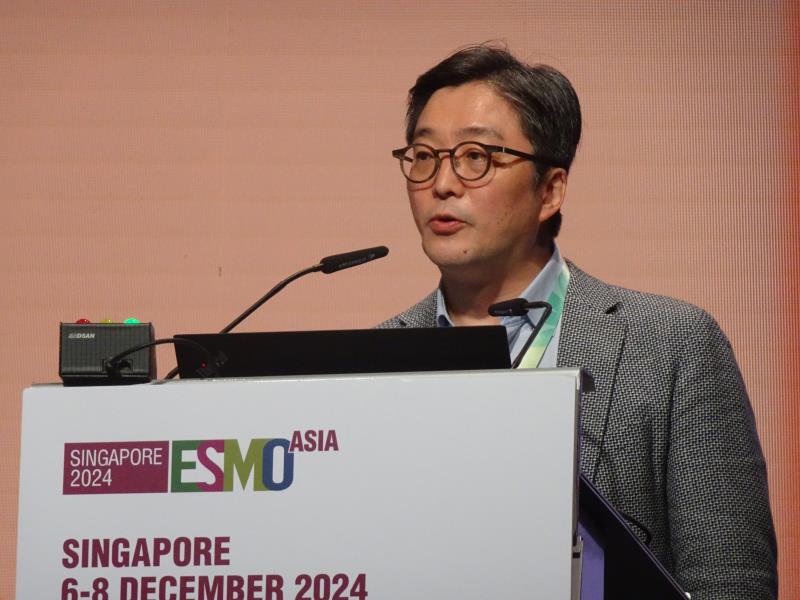PALOMA-3: Subcutaneous amivantamab makes the grade in Asians with EGFR+ NSCLC




 Dr Se-Hoon Lee at the ESMO Asia Congress 2024
Dr Se-Hoon Lee at the ESMO Asia Congress 2024For Asian patients with EGFR-mutated advanced non-small-cell lung cancer (NSCLC), subcutaneous (SC) delivery of amivantamab plus lazertinib does not alter the drug’s pharmacokinetic and efficacy profile compared with the intravenous (IV) approach and is associated with fewer infusion-related reactions, according to a subgroup analysis of the phase III PALOMA-3 trial.
As observed in the overall PALOMA-3 population, pharmacokinetic exposures and efficacy results were similar between the SC arm and the IV arm in Asian patients, reported first study author Dr Se-Hoon Lee from the Samsung Medical Center, Sungkyunkwan University School of Medicine in Seoul, South Korea. [J Clin Oncol 2024;42:3593-3605]
There were no significant between-arm differences in trough concentration at cycle 2, day 1 (Ctrough: geometric mean ratio, 1.11, 90 percent confidence interval [CI], 0.97–1.28) and total systemic exposure (area under the serum concentration time curve from day 1 to 15: geometric mean ratio, 1.03, 90 percent CI, 0.96–1.10). [ESMO Asia 2024, abstract 628MO]
Over a median follow-up of 6.9 months, the disease control rate was 80 percent in the SC arm vs 73 percent in the IV arm. The median duration of response was not estimable for SC amivantamab vs 7.1 months for its IV counterpart.
In terms of survival, Lee noted a favourable progression-free survival (PFS) trend with SC vs IV amivantamab (not estimable vs 5.59 months; hazard ratio [HR], 0.84, 95 percent CI, 0.58–1.22; p=0.35). Overall survival was not estimable in both treatment arms (HR, 0.60, 95 percent CI, 0.33–1.08; p=0.08), but the percentage of patients alive at 12 months was numerically higher in the SC arm than in the IV arm (77 percent vs 61 percent).
Safety events
“The safety profile for Asian patients was consistent with the overall population,” Lee said.
Treatment-emergent adverse events (TEAEs) occurred in 99 percent of patients each in the SC arm and the IV arm, including grade 3 or higher AEs in 46 percent and 53 percent and serious AEs in 26 percent and 30 percent, respectively. AEs led to death in 3 percent of patients in each arm and to treatment discontinuation in 8 percent of patients in the SC arm and in 11 percent in the IV arm.
For AEs of special interest, rash occurred with similar frequency in the SC and IV arms (81 percent vs 80 percent, respectively), and the incidence of pneumonitis/interstitial lung disease was low at 3 percent with SC vs 1 percent with IV amivantamab.
However, the frequency of IRRs was sixfold lower with SC vs IV amivantamab (10 percent vs 61 percent), and these reactions were mostly grade 1 to 2.
Lee pointed out that the incidence of venous thromboembolism was low and further reduced with prophylactic anticoagulation, which was administered to 74 percent of patients in the SC arm and 75 percent of those in the IV arm during the initial 4 months of treatment. The risk of severe bleeding (grade ≥3) was low in the presence of prophylactic anticoagulation (2 percent in the SC arm vs 1 percent in the IV arm).
Taken together, the PALOMA-3 subgroup data highlight the potential of subcutaneous injection as a preferred administration route for amivantamab in Asian patients with EGFR-mutant advanced NSCLC.
Of the 418 patients who were included in PALOMA-3, 255 were Asian and included in the subgroup analysis. Of these, 126 patients were in the SC arm (median age 61 years, 66 percent female) and 129 in the IV arm (median age 62 years, 69 percent female). The patients received a median of 2 prior lines of therapy.